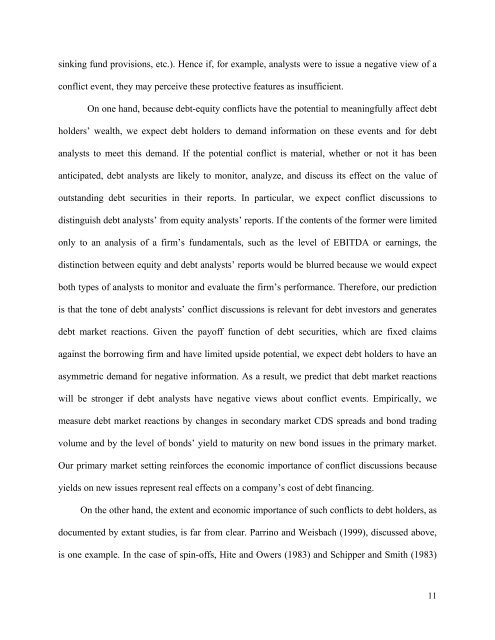Debt Analysts' Views of Debt-Equity Conflicts of Interest
Debt Analysts' Views of Debt-Equity Conflicts of Interest
Debt Analysts' Views of Debt-Equity Conflicts of Interest
You also want an ePaper? Increase the reach of your titles
YUMPU automatically turns print PDFs into web optimized ePapers that Google loves.
sinking fund provisions, etc.). Hence if, for example, analysts were to issue a negative view <strong>of</strong> a<br />
conflict event, they may perceive these protective features as insufficient.<br />
On one hand, because debt-equity conflicts have the potential to meaningfully affect debt<br />
holders’ wealth, we expect debt holders to demand information on these events and for debt<br />
analysts to meet this demand. If the potential conflict is material, whether or not it has been<br />
anticipated, debt analysts are likely to monitor, analyze, and discuss its effect on the value <strong>of</strong><br />
outstanding debt securities in their reports. In particular, we expect conflict discussions to<br />
distinguish debt analysts’ from equity analysts’ reports. If the contents <strong>of</strong> the former were limited<br />
only to an analysis <strong>of</strong> a firm’s fundamentals, such as the level <strong>of</strong> EBITDA or earnings, the<br />
distinction between equity and debt analysts’ reports would be blurred because we would expect<br />
both types <strong>of</strong> analysts to monitor and evaluate the firm’s performance. Therefore, our prediction<br />
is that the tone <strong>of</strong> debt analysts’ conflict discussions is relevant for debt investors and generates<br />
debt market reactions. Given the pay<strong>of</strong>f function <strong>of</strong> debt securities, which are fixed claims<br />
against the borrowing firm and have limited upside potential, we expect debt holders to have an<br />
asymmetric demand for negative information. As a result, we predict that debt market reactions<br />
will be stronger if debt analysts have negative views about conflict events. Empirically, we<br />
measure debt market reactions by changes in secondary market CDS spreads and bond trading<br />
volume and by the level <strong>of</strong> bonds’ yield to maturity on new bond issues in the primary market.<br />
Our primary market setting reinforces the economic importance <strong>of</strong> conflict discussions because<br />
yields on new issues represent real effects on a company’s cost <strong>of</strong> debt financing.<br />
On the other hand, the extent and economic importance <strong>of</strong> such conflicts to debt holders, as<br />
documented by extant studies, is far from clear. Parrino and Weisbach (1999), discussed above,<br />
is one example. In the case <strong>of</strong> spin-<strong>of</strong>fs, Hite and Owers (1983) and Schipper and Smith (1983)<br />
11
















